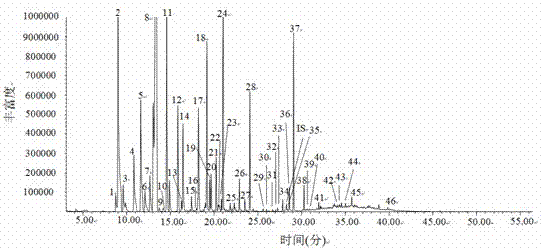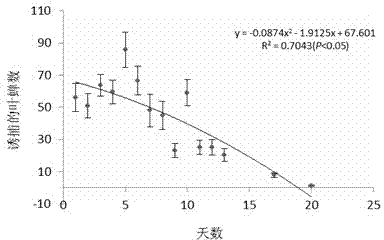Method for trapping empoasca vitis gothe by means of tea plantation weed rosemary smell
A technology of false-eyed small green leafhopper and rosemary, which is applied to the device, application, animal husbandry and other directions of catching or killing insects, can solve problems such as excessive pesticide residues in tea, and achieves effective trapping, fast trapping speed and simple method. easy effect
- Summary
- Abstract
- Description
- Claims
- Application Information
AI Technical Summary
Problems solved by technology
Method used
Image
Examples
Embodiment 1
[0028] The first step is the test of rosemary smell to lure the small green leafhopper with false eyes
[0029] 1. Flavor source
[0030] Rosemary Rosmarinus officinalis L. is a weed that grows naturally in the tea garden of China Jiliang University. During the experiment, the young part was cut as a flavor source material to release the smell to attract the green leafhopper with false eyes. A total of 6 doses of 1g, 2g, 3g, 5g, 7g, and 9g were set up, and each dose was tested 5 times.
[0031] 2. Insects to be tested
[0032] The female and male adult green leafhoppers with false eyes were collected from the tea garden of China Jiliang University, and they were raised on potted tea trees in insect cages, allowing them to mate and lay eggs freely. When the eggs hatch and grow into 3rd instar nymphs, they are used as test insects. Half an hour before the test, the 3rd instar nymphs were taken and stored in test tubes for later use, and they were fasted.
[0033] 3. Y-shape ...
Embodiment 2
[0088] Example 2 Time rhythm of leafhoppers flying to five-component lures in tea gardens
[0089] 1, adopt 4 kinds of lures in the 5th step of embodiment 1, attach to the jasmine yellow sticky board respectively, carry out the test in the tea garden with reference to the 5th step procedure, every kind of lure repeats 30 times. Divide a day into the following 7 time periods: 18:00-6:00, 6:00-8:00, 8:00-10:00, 10:00-12:00, 12:00-14:00, 14:00-16:00 and 16:00-18:00. The number of leafhoppers on the swatches was surveyed in the last 30 minutes of each session. From July 21st to July 26th, a 6-day time rhythm survey was conducted.
[0090] The difference between the number of leafhoppers trapped by each lure in 7 time periods per day was analyzed by variance, and the difference was compared by Duncan’s new multiple range, which proved that the lure effect of the five-component lure in rosemary smell was significant.
[0091] 2. Results
[0092] Each lure attracts the most leafh...
Embodiment 3
[0093] Example 3 The control effect of rosemary odor six-component lure in the field for the small green leafhopper with false eyes
[0094] 1. In the tea area of Anhui Province, early September to late November is the peak period for the population of Leafhopper with false eyes. On September 8, the tea plantation of Magushan tea farm in southern Anhui was selected to produce tea. Setting: 20 six-component lures + jasmine yellow sticky boards / 667m 2 ;Treatment 2: 20 Blend2 lures + jasmine yellow sticky boards / 667m 2 ;Treatment 3: 20 n-hexane lures + jasmine yellow sticky boards / 667m 2 ;treatment 4: 0 traps / 667m 2 Namely CK. Each lure is repeated 3 times, and the area of each repetition is 667m 2 tea garden.
[0095] From 10:00 am to 12:00 am on September 8, samples were taken at 5 points in 12 plots with 4 treatments, and a 1-meter tea row was taken from each sample point, divided into two longitudinally, and the tea branches were patted vigorously, covered with a pla...
PUM
 Login to View More
Login to View More Abstract
Description
Claims
Application Information
 Login to View More
Login to View More - R&D
- Intellectual Property
- Life Sciences
- Materials
- Tech Scout
- Unparalleled Data Quality
- Higher Quality Content
- 60% Fewer Hallucinations
Browse by: Latest US Patents, China's latest patents, Technical Efficacy Thesaurus, Application Domain, Technology Topic, Popular Technical Reports.
© 2025 PatSnap. All rights reserved.Legal|Privacy policy|Modern Slavery Act Transparency Statement|Sitemap|About US| Contact US: help@patsnap.com



